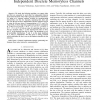Free Online Productivity Tools
i2Speak
i2Symbol
i2OCR
iTex2Img
iWeb2Print
iWeb2Shot
i2Type
iPdf2Split
iPdf2Merge
i2Bopomofo
i2Arabic
i2Style
i2Image
i2PDF
iLatex2Rtf
Sci2ools
TIT
1998
1998
The Common Randomness Capacity of a Pair of Independent Discrete Memoryless Channels
—We study the following problem: two agents Alice and Bob are connected to each other by independent discrete memoryless channels. They wish to generate common randomness, i.e., agree on a common random variable, by communicating interactively over the two channels. Assuming that Alice and Bob are allowed access to independent external random sources at rates (in bits per step of communication) of HA and HB, respectively, we show that they can generate common randomness at a rate of maxfmin[HA + H(W j Q); I(P ; V )] + min[HB + H(V j P ); I(Q; W )]g bits per step, by exploiting the noise on the two channels. Here, V is the channel from Alice to Bob, and W is the channel from Bob to Alice. The maximum is over all probability distributions P and Q on the input alphabets of V and W , respectively. We also prove a strong converse which establishes the above rate as the highest attainable in this situation.
| Added | 23 Dec 2010 |
| Updated | 23 Dec 2010 |
| Type | Journal |
| Year | 1998 |
| Where | TIT |
| Authors | Sivarama Venkatesan, Venkat Anantharam |
Comments (0)

